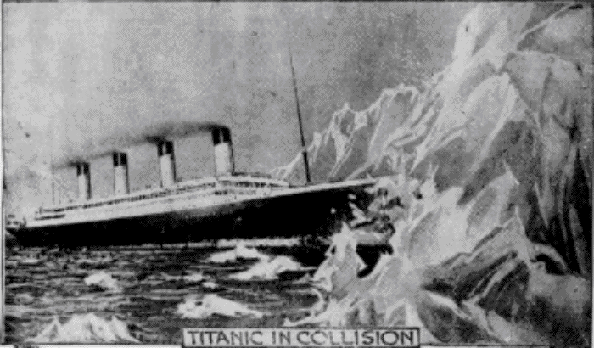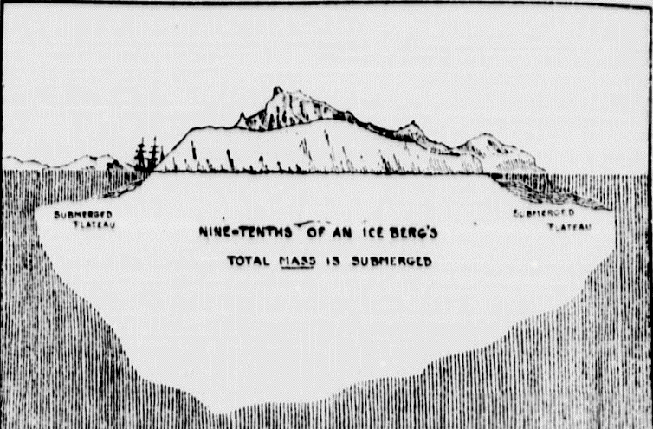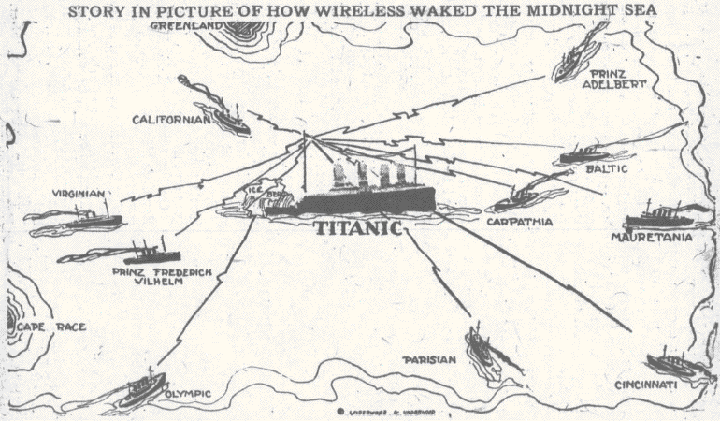Facts about the Titanic and the Titanic tragedy. Page 1
The White Star Liner RMS Titanic
The RMS Titanic (Royal Mail Ship Titanic) was a British passenger liner.
On 25 November 1908, the White Star Line, a subsidiary of the International Mercantile Marine Company, officially announced
that the names of the second of it's two great liners, which were to be built, would be the Titanic. Incidently, it was announced
that the tonnage of each vessel (Titanic and Olympic) would be about 60,000, which was nearly twice that of
the Mauretania. The keel blocks for the first of these amazing ships, the Olympic, were laid down at Belfast the previous
week. The keel blocks for the Titanic would be laid down in January 1909.
Great preperations had been going on at Belfast for more than a year for the constructions of the great vessels. Two new
docks, each more than a thousand feet long and capable of bearing a weight of 75,000 tons, had been built.
The RMS Titanic was built by the Harland And Wolff Shipyard in Belfast. Construction began in 1909.
The Titanic's yard number was SS401 and she was built on slipway number three.
One of the primary designers was Lord James Pirrie, who was a partner at Harland and Wolff. He and J. Bruce Ismay, who
was the managing director at White Star Line, were largely responsible for the designing and construction of the steam liners.
It is interesting to compare the Titanic and Olympic with some of the other famous ships of their day. The first Cunard ship
to cross the Atlantic was the Britannia, which made the crossing in 1840. Her tonnage was 1,154, and she was 207 ft. long.
The Scotis, which was referred to as an "Leviathan" in 1862 had a tonnage of 3,871. The tonnage of either the Olympic or
Titanic was more than the Spanish Armada, which was 59,120.


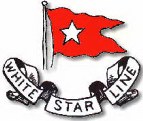
Images: Joseph Bruce Ismay, Thomas Henry Ismay and the WSL logo
Thomas Ismay purchased the White Star Line for £1000 in 1867 from Henry Wilson. The White Star Line was originally
founded in Liverpool in 1845 by John Pilkington and Henry Wilson. After the death of his father on 23 November 1899,
Bruce Ismay succeeded him as the chairman of White Star Line.
Bruce Ismay was high in the social strata of the world. A wealthy steamship magnate, He did as he pleased. He was not
only in the top notch of the social and business world, but he was surrounded by fawning millionaires.
He was president of the International Mercantile Marine Company and chairman of the board of directors and managing
director of the White Star Line.
In January 1913 he resigned from his place as managing director of the White Star Line. Resigned as head (president) of
the International Mercantile Marine Company (IMM).
He was succeeded by Harold A. Sanderson. Although Ismay resigned as chairman of the White Star he continued as a
director of the International Mercantile Marine, and a member of the British committee and retained the chairmanship of
the Asiatic Steamship Company and the Liverpool and London Steamship Protective association.
The RMS Titanic was the second in a set of three super Olympic Class Ocean Liners - the Olympic, the Titanic and the
Britannic operated by White Star Line.
The Titanic was one of a fleet of thirteen ships employed in the transport of passengers, mails, and cargo between Great
Britain and the United States
March 6, 1912: Titanic (right) had to be moved out of the drydock so her sister Olympic, which had lost a propeller,
could have it replaced
The Titanic owned by the White Star Line, was the largest ship at that time and was considered unsinkable thanks to a
double-bottomed hull divided into 16 watertight compartments.
There were 15 bulkheads in the Titanic. Two of these were what was known as collision bulkheads and the other thirteen
were water tight and of the kind common to modern steamers. One collision bulkhead was in the forepart of the hull, fifty
feet from the bow. It was of steel, with no inlet the hold, and it was entered from the main deck. The other collision bulkhead
was at the stern and also must be entered from the main deck.
The other thirteen bulkheads divide the hull of the
Titanic into seperate compartments and doors into these divisions and can be closed seperately or all at one time. The
closing mechanism was hydraulic. There was, however, an element of weakness in the strongest of water-tight bulkheads
which lied in the pressure resisting power of the bulkheads. While it was claimed that two compartments of the Titanic
could be flooded with water without the vessel sinking, it was admitted that, were any of the compartments flooded with
water, the pressure of water on those bulkheads might cause a leak which would admit water into the next compartment
and so on from one bulkhead to the next, until the hull was water-logged.
______________________________________
What is a bulkhead? A bulkhead is an upright internal watertight wall within the hull of a ship. One of the reasons to install
bulkheads is to divide a space into seperate usable watertight compartments. Compartments created with bulkheads have
the ability to contain water in case of a leak and create firebreaks to contain fires so that the entire ship is not damaged.
A hull is the watertight body of a ship or boat.
The bow is the forward part of the hull of a ship or boat. The stern is the rear of a ship.
A rudder is a device used to steer a ship
______________________________________
The RMS Titanic was the world's largest manmade wonder, most luxurious, and expensive ship ever built in those days
- a "floating palace", as reporters called it - turkish baths (a wonder in marine architecture), staterooms (Stateroom B-58
onboard Titanic was decorated in Louis XVI style, B-59, in Old Dutch style), a first class gymnasium, reading and writing
room on the A-Deck mainly for the use of first class women, A La Carte restaurant, cafe Parisien, parlors, a splendid dining
saloon, a swimmingpool and indoor gardens. Passengers were provided with environments to make them believe they were
still on land.
Cost - $10,000,000
Insured for $5,000,000
Two regal suites on the Titanic cost $4, 850 per trip.
Gross tonnage - 46,328.
More than three million rivets were used to make the Titanic.
There were 254 recorded accidents with 8 fatalities during the construction of the Titanic
It took 15 000 skilled men to built the Titanic
Employed 800 Carpenters
Lifebuoys. - Forty-eight, with beckets
Lifebelts. - 3,560 lifebelts
It was as tall as a 12 storey building.
Breadth - 92 feet 6 inches.
Length over all - 882 feet and 6 inches
Number of steel decks - 11
Rudder - 100 Tons
Wing propellers each - 38 Tons
Center propeller - 22 Tons
Anchors each - 15 and a 1/2 Tons
She had three engines. Two outer sets of reciprocating engines driving the wing propellers, and a low-pressure turbine
working the centre propeller.
104 feet high from keel to navigation bridge
Speed - 22 1/2 knots
Crew - 860
Passenger and crew capacity - 3547 persons
In speed the Titanic could not compete with the Lusitania and the Mauretania.
On its maiden voyage the Titanic carried 2224 passengers including children, immigrants, prominent persons, millionaires
and crew members. There were 30 dogs aboard belonging to first cabin passengers, all of them the best of their sort in
the dog line. The dogs were cared for and fed by the ship's butcher.
Passengers on the Titanic was divided into 3 classes. First, second and third classes.
The RMS Titanic carried only 20 lifeboats - 14 standard wooden Harland and Wolff lifeboats with a capacity of 65 people
each and four Englehardt "collapsible" lifeboats (identified as A to D) with a capacity of 47 people each and two emergency
wood cutters with a capacity of 40 persons each, fulfilling all the requirements of the British Board of Trade
These 20 lifeboats could hold only half the Titanic's 2224 passengers (about 1178 passengers and crew members) while
but just more than 700 were saved after the collision. Safety was'nt a concern for what was designed to be an unsinkable
ship.
If the Titanic had been built under the United States Law, it would have been equipped with 23,670 cubit feet of lifeboat
space, which at 10 cubit feet to a person, would accommodate 2,367 people. Under the United States Law, two-thirds
of the capacity must be in properly built lifeboats, the remaining one-third made of approved type of liferafts or collapsible
lifeboats. Thus regular lifeboat capacity would have accommodated 1,578 people and liferafts or collapsible lifeboats 789 people.
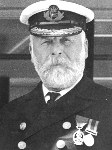
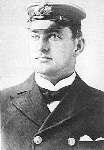
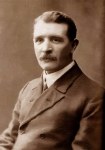
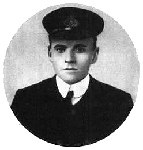
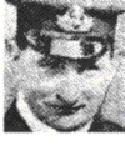
Images. 1) In charge of the Titanic - Master. Captain Edward John Smith. 2) Chief Officer - Henry Tingle Wilde. 3 and 4)
1st and 2nd officers William McMaster Murdoch and Charles Lightoller. 5) 4th Officer J. G. Boxhall.
Other officers:
3rd Officer H. J. Pitman
5th Officer H. G. Lowe
6th Officer J. P. Moody

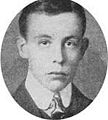
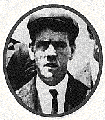
Images. 1) Senior Marconi operator on the Titanic, Jack Phillips and 2) fellow Marconi operator on the Titanic, Harold Bride.
3) Frederick Fleet.
Engine Department included the Chief Engineer and 7 senior and 17 assistant engineers
Surgeon - W.F.N. O'Loughlin
Asst. Surgeon - J.E. Simpson
Titanic's maiden voyage until the time of her sinking
The RMS Titanic was launched at 12:15 pm on 31 May 1911.
Her sea trials began on Monday, 2 April 1912
Wednesday, 10 April 1912
The RMS Titanic began its maiden voyage from Southampton, called at Cherbourg in France (10 April) and then Queens-
town (now Cobh) in Ireland (Thursday, 11 April), the final port of call for the Titanic as she set out across the Atlantic westwards
to New New York. From the very first day the speed of the Titanic was gradually increased.
The weather was perfectly clear and fine. There was no moon, the stars were out, and there was not a cloud in the sky
since leaving. Temperature was 33 deg. F., and it eventually fell to 32 deg. F.
From friday, 12 April to sunday, 14 April 1912
Titanic now out in the Atlantic ocean covers long distances. Wireless messages received by the Titanic operators contained
greetings and congratulations and several ice (large ice bergs, ice and ice fields) warnings coming from the Caronia,
the Baltic, the Mesaba, the Californian and the Amerika. Some other vessels in the vicinity at the time: the Prinz Friedrich
Wilhelm, the Carpathia, the Parisian, the Athenai, the oil tank steamer Deutschland, the Antillian and the Frankfurt.
Lightoller turned over the ship to Murdoch, the first officer, at 10 o'clock.
10.20 pm, the Californian encountered an ice field and had to stop. Her position was 41.05N., 50.07 W. The wireless operator
Cyril Evans on the Californian then informed the Marconi operator on the Titanic "Say old man, we are stopped and surrounded
by ice," Jack Phillips the senior wireless operator on the Titanic replied: "Keep out! Shut up! You're jamming my signal.
I'm working Cape Race."
The reason why Phillips used those words was because the communication between him and Cape Race was interrupted
by Evans. Evans ceased his transmission but still listened in to the Titanic's communication with Cape Race up to the time
he went to sleep at 11.30 pm.
This was the last ice warning. The Titanic's speed was not reduced. It was now steaming at over 22 knots towards an icefield
of over 70 miles long.
Four days after launch - In the North Atlantic Ocean about 450 miles south of Cape Race, the most westerly point of
Newfoundland and 1150 miles due east of New York. Frederick Fleet spotted a black mass of ice ahead. The iceberg,
of course was difficult to see because there was no moon, the night was dark. The iceberg looked like a black bump
on the horizon. Fleet rang the crows nest bell.
If he had had glasses he could have seen the iceberg enough sooner to
have escaped it. There were no lookout glasses (binoculars) in the Titanic's crow's nest after leaving Southampton.
Boxhall said he could see the iceberg dimly. It lay low in the water and was as high as the lower rail of the ship or about
30 feet out of the water. As usual, the great bulk of the iceberg was below the surface. It is certain, that the greatest of
these icebergs and of the kind that the mariners call a "blue bird"stood directly in the path of the Titanic.
Then he called the bridge. "Iceberg, right ahead!" Murdoch ordered the Titanic to turn (turned about two points to port) and
put the engines in reverse - in his own words "Hard-a-starboard," and down to the engine room "Stop. Full speed astern."
but it was too late. The RMS Titanic collided with a submerged iceberg or underwater (submerged) plateau of an iceberg
on the starboard side shortly before midnight.When the collision came there was little impact and just a sharp, grinding
noise. Time 11.40 pm.
Hidden danger is under water. Icebergs not infrequently have outlining spurs or submerged plateaus.
Nine-tenths of an ice berg's total mass is submerged.
"There was a slight shock through the entire ship, but absolutely no severe jolt that would have caused us worry. I was suddenly
aware that the engines had stopped. They tried to start the engines a few minutes later, but, after some coughing and
rumbling, there was silence once more."
"The ship reversed its engines immediately after striking the berg and was brought to a standstill. It remained practically stationary until it went down."
From the Hydrographic Office. Washington DC
Daily Memorandum. April 15, 1912
As it scraped along the iceberg a 300 foot gash was torn through the hull (to the bottom of the starboard side) well below
the waterline flooding 5 of the 16 compartments to the sea. The Starboard in nautical terms refers to the right side of a
ship. The left side is the Portside. The line where the hull meets the water surface is called the waterline.
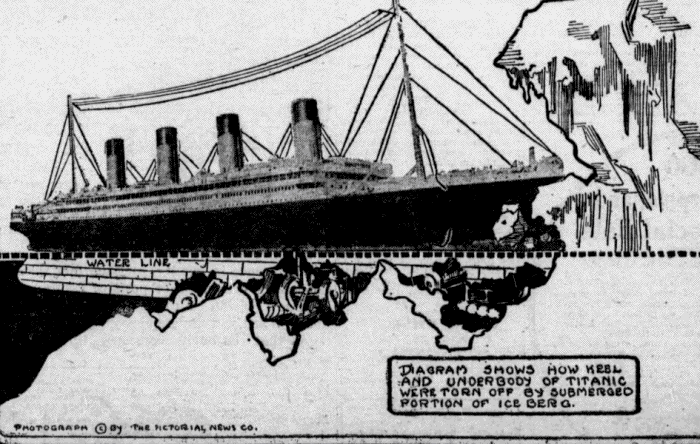
Water was pouring in. Murdoch ordered to close the eleven vertically closing watertight doors but sea water was already gashing
into the bowels of the ship. After the first ten minutes, the water rose steadily in 6 compartments. Five minutes
after the collision water was seen rushing in at the bottom of the firemen's passage on the starboard side. Water flooded
the mail room and above G deck in 25 to 30 min, the baggage room in 25 min, the seamen's quarters on E deck in 40 min.
Then followed the boiler rooms. The flooding of deck E contributed largely to the sinking of vessel. This was more than
the ship would sustain. It was just plain common sense that the ship was going to sink. The passengers were at first
assured that the ship was in no danger and was unsinkable.
It is conceivable that in developing longitudinal strength in a ship of such great dimensions as the Titanic the longitudinal
girders might be of such great strength and rigidity than instead of huckling forward, as on an ordinary ship, when it crashed
into the berg they might deliver a thrust backward to the transverse bulkheads that would cause the rendering of the rivets,
ripping of seams and such general distortion sufficient to cause these bulkheads to leak. Such leakage is progressive in that,
as the water comes in and rises up in the bulkheads, the pressure increases so that ones the forward bulkheads were
damaged sufficiently to allow water to enter it would only a question of time when the vessel would sink.
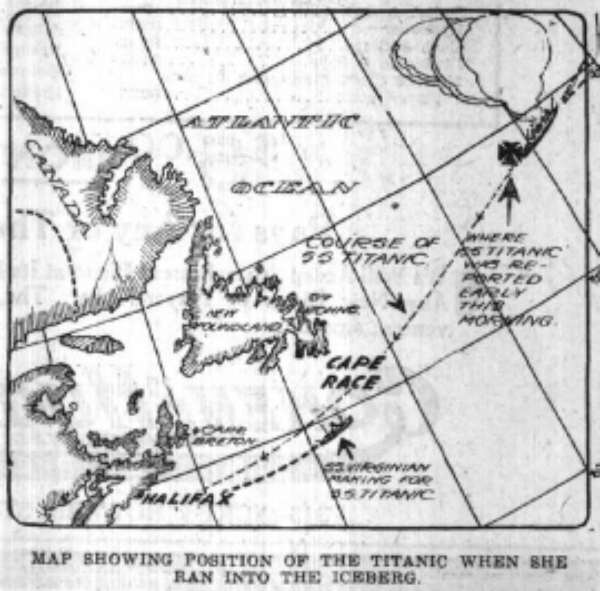
Moments after the collision captain Smith rushed to the bridge. Bruce Ismay managing director of the white Star Line
also felt the ship shatter. He too came up to see what had happened. Captain Smith asked Thomas Andrews, the ship's
designer to assess the damage. Andrews replied the ship had less than two hours to live.
Captain Smith was faced with a seamans worst nightmare, the ship was sinking and he knew there were only enough
lifeboats to save less than half of Titanic's passengers. The captain gave his crew orders to uncover the lifeboats. There
were a few passengers on the deck at this time.
Word of the disaster spread slowly across the ship. The stewards were despatched to all three classes where they poun-
ded on cabin doors waking passengers ordering them up to the deck with their lifebelts on.
Many of the people did'nt know why they were getting into the lifeboats. Captain Smith instructed his officers to load
women and children first into the lifeboats but many wifes were reluctant to obey orders. As soon as men passengers
tried to get to the boats they were shot at. Captain Smith told the wireless operators Jack Phillips and Harold Bride to
send the international call for help which was C.Q.D. Distress signals were fired until two hours after the collision
(1.45 am.). At this time the fore deck was under water.
1st Officer Murdoch who was in command killed himself (shot himself) later.
Monday morning,15 April 1912
At 12.15 am the Titanic's wireless operators sent out the distress call (C.Q.D - "Come Quick, Danger"). It was picked up
by the wireless station at Cape Race and vessels in the vicinity:
The Californian, 19 1/2 miles distant from the Titanic.
The Mount Temple, 49 miles. At 10.25 o'clock on the night of sunday, April 14, the Mount Temple received the first of the
Titanic's C.Q.D. calls for help. On its way to the Titanic, Captain Moore met a schooner, a small craft. It was between the
Mount Temple and the Titanic. The schooner was coming from the direction of the Titanic.
The Carpathia, 58 miles.
The Birma, a Russian ship, 70 miles.
The Frankfurt, 153 miles.
The Virginian, about 170 miles.
The Baltic, about 243 miles southeast of the Titanic.
The Olympic, about 512 miles away and 200 miles from New York enroute to Southampton.
The Cincinnati, about 550 miles.
Captain Smith was blamed for ignoring ice warnings and forging ahead at a high rate of speed (23 knots an hour). But Smith
expiated his fault by a heroic death. There was no reason for sailing at such a high rate of speed. She was a day ahead of
her schedule and its considered probable that an attempt to make a record breaking voyage was the hope of her crew when
she entered the ice field.
Donald S. Sutherland, wireless operator of the Parisian said: "Captain Smith must have known of the gigantic icebergs,
the largest seen in years, that lay directly in his course.
The Parisian was about 100 miles ahead of the Titanic. It passed through the ice field on which the Titanic went to its end..
The liner Mesaba was between the Parisian and the Titanic.
A safer route from Europe to America.
By selecting a more southerly and safer route from Europe to America instead of the northern lane, in which it went down,
the Titanic would have traveled 113 miles farther and taken only 5 hours more to effect a 5 days voyage, according to Captain
Charles A. Meallister.
"The hydrographic charts," show that the distance from Queenstown to New York by the southern and safe route is 2,936
miles; by the northern route, taken by the Titanic, the distance is 2,823 miles.












